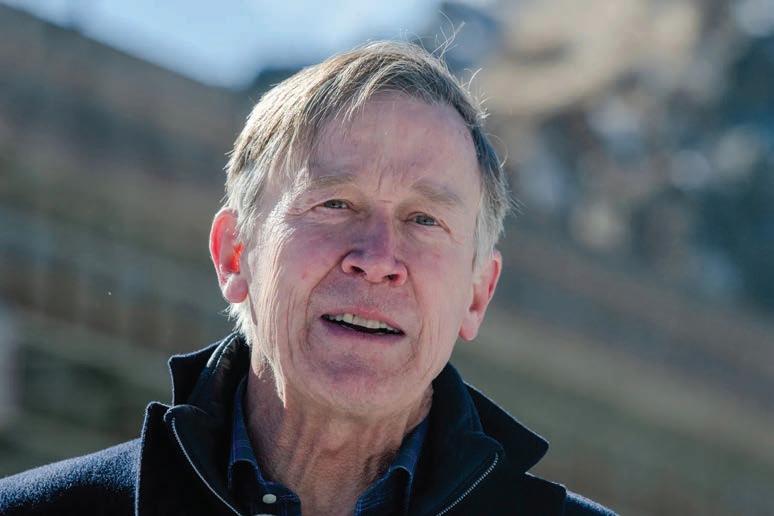
6 minute read
Film Festival Is Back Live Next Week, Featuring 90+ Films
of Activism,” and look forward to seeing the full 53-minute Australian film about six young women activists out to save the planet. “Purple Haze” is about the purple martin, described as “America’s favorite backyard bird.”
An in-person “all access” pass costs $90 and can be purchased at the same website. The virtual pass is $75.
As before, the films are combined into 28 “collections” such as the “Activism Collection” (my favorite), which can be purchased for $12 each if you don’t want to buy the all-access or virtual pass. All the information is on that website. Click on the “Menu” link at the top left of the website to see the various pages with all the information you need to attend the festival.
Bill in Legislature Would Enlarge Board of Commissioners
Back in 2013-2014, I was part of a group called “Jeffco5” which ran an unsuccessful petition drive to put on the 2014 ballot an initiative that would increase the number of Jeffco Commissioners from three to five and to require that they be elected by district instead of at large.
At the time, the Jeffco Board of Commissioners consisted to two Republicans and one Democrat, and they voted 2-1 against enlarging the board to five members, hence the petition drive. Like our 5-member school board, all three commissioners must run countywide, even though they are assigned one-third of the county as their “district.”
I mistakenly assumed that once at least two of the commissioners were Democrats, that they would put the measure on the ballot. Currently, all three commissioners are Democrats, and it’s still not happening.
Last week I ran into one of the commissioners, Andy Kerr, at an event honoring Brittany Petterson, our new member of Congress who succeeded Ed Perlmutter, and asked him about the idea.
He said he favored it, but informed me about a bill (HB23-1180 ) being put forward in the General Assembly by Rep. Bob Marshall and State Sen. Kevin Priola which would require all counties with a population over 70,000 to have five county commissioners, at least three of whom are elected by district. Andy told me that if that measure fails, he would consider convincing his fellow commissioners to put such a measure on the Jeffco ballot this fall.
Colorado’s Open Meetings Law (OML), which originated in a citizen initiative known as the Colorado Sunshine Act of 1972, defines a meeting as “any kind of gathering, convened to discuss public business, in person, by telephone, electronically, or by other means of communication.” It prohibits any members constituting a quorum of a “local public body” from even talking with each other about a public policy without that meeting being given “full and timely notice” and being opened to the public.
The implications are that any Jeffco commissioner who converses with or emails a fellow commissioner about a county policy or issue is violating state law, because together they would constitute a quorum of the 3-member Board of County Commissioners. To me, this is the compelling reason why the board must be enlarged to five members.
The argument for electing the commissioners (and school board members) by district instead of at large is equally compelling. If each commissioner must win the votes of a plurality of voters countywide, he or she is not going to give his assigned portion of the county the attention it deserves.
I will testify in favor or HB23-1180 and urged our commissioner to do so as well.
As in past festivals, there is a free (but ticket required) “Community Opening Night” on the 23rd which includes announcement of the winning films in various categories. It starts at 6 pm in the AMC auditorium and is followed at 7:15 by the screening of seven of the awardwinning films, ranging from a one- ue for the festival at the American Mountaineering Center, but a second theater is created in the AMC’s event center to accommodate all the screenings, which begin at 10 a.m. from Friday through Sunday. The virtual access ticket (which I’m going to get) allows you seven days to watch any or all of the films on demand.
The festival features young filmmakers from around the nation including minute PSA to a couple 23-minute films. I never miss this event, which is held in the AMC’s Foss auditorium.
Although CEFF is an international film festival, several of the “collections” feature films made by Colorado filmmakers. There are also 16 “accessible collections” which are either captioned, subtitled or have no dialog. One collection is of the “Top 10 Best Kids’ Short Films.”
Other collections which caught my attention include: Art in Nature; Climate Chaos; Feathered Friends & More; Innovation & Inspiration; Off the Beaten Path; People to Know; Special Places; Unique Solutions; and two Wildlife Collections
If you are reading this column in time, there’s a free Festival Preview at the University of Denver’s Sturm Hall on Thursday, Feb. 16th, 6:30 to 8:30 pm.
The Foss auditorium is the main ven-
Hawaiian youth-made films like “Sunscreen Standoff,” and local Colorado young filmmakers like Taylor Saulsbury who gives voice to her generation's climate anxieties, creating portraits of resistance and resilience in “Right Here. Right Now.”
Join in the free virtual “Green Bag Lunch & Learn Series” to hear from local experts as they dig deeper into current event environmental issues, including a closer look at the impact of Climate Chaos on young people’s mental health (Wednesday, March 1st at noon).
By attending the festival in person, you get to join the conversation with Filmmaker Q&A Sessions after many of the films to chat live with the filmmakers in attendance or watch one of the many recorded sessions to hear the secrets and intriguing behind-the-scenes stories of the films featured in this year’s festival. Don’t miss this great festival! Jim
JCEA’s presentation said. Addressing learning gaps “are not going to happen on the y,” they added.

Board Vice President Susan Miller questioned how to analytically show that extra planning time was actually e ective.
“I would like to know, you said at the very beginning in bargaining, we’d improve student learning outcomes, and I’d like to understand how that happens,” Miller said. “Because I’d like to understand if we give more PLC time, if we provide more planning at the di erent levels, etc., what is the bene t for our children that we should be able to measure?”
Williams told Colorado Community Media that she “doesn’t think it’s any secret that teachers need time to make phone calls to parents, they need time to grade and they need time to prepare their lessons.”
She added that having enough time to also observe other teachers would be bene cial.
“We’re not asking for less time with our kids, we’re just asking that our planning time be protected,” she said.
Compensation was the other making by the council that could lead to those types of changes. major topic of discussion. e JCEA said they feel good about the previous salary increases for this school year, but that, due to rising costs of living, “people are seeing whatever raise they got going away.”
“Most of the time it feels like we are ghting just to stay even with where we were,” they added. e union cited state-wide statistics from the Colorado Education Association that found almost 65% of teachers were thinking of leaving the profession, and that this shortage is negatively a ecting all teachers. multi-family and single-family development.
According to a survey by the JCEA, 61% of educators thought that higher compensation would help solve the issue of teacher shortages.


In connection with compensation, the JCEA also said teacher’s insurance had too high premiums and was so costly that their children were qualifying for medicaid.
“It’s absolutely ridiculous that I’ve lived in Je co for 13 years, and every year my two kids qualify for medicaid because I’ve never been able to add them to the District’s plan with my single income as a classroom teacher. It’s beyond ridiculous, it’s insulting,” said one comment the JCEA presented from their survey.
According to the JCEA’s presented schedule, they hope for bargaining to be nished by May.

The City highlights that the report will not change zoning or municipal codes itself, rather it will act as a guide for decision-

Councilmember Sophia MayottGuerrero, for example, spoke briefly about the advantages of density — such as less water waste and more efficient land use — after a question by Councilmember Rich Olver on the upper limits of housing development in Lakewood in the study session.
“When we have more density, we actually have a smaller water impact per person and household,” she said. “Although, of course, we want to have reasonable sustainability practices, I hope that we are focused on creating an affordable, accessible, sustainable community and I actually think we can help with that.”
She also highlighted the need for affordable housing for middleincome residents — not just subsidized housing, but simply cheaper housing.
The plan began in October with the company’s analysis of Lakewood, with a community survey being put out now. The city expects a draft strategic housing plan to be released in summer of 2023.








